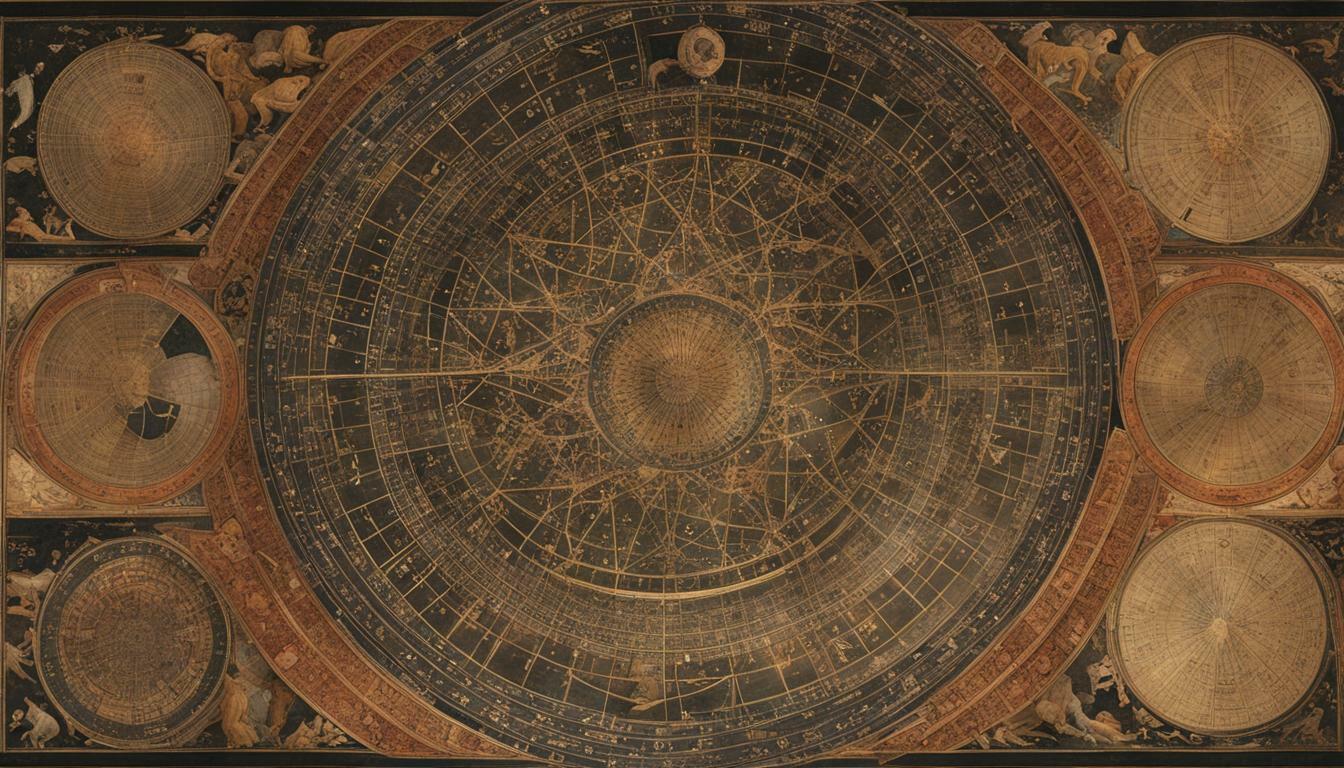Mastering the Art: How to Read a Vedic Astrology Chart
If you’re interested in Vedic astrology, you’ve probably come across a Vedic astrology chart. This complex system of astrology provides valuable insights into an individual’s past, present, and future. However, reading a Vedic astrology chart can seem overwhelming at first. But don’t worry, with a little guidance and practice, you can learn how to read these charts like a pro.
In this section, we will provide an introduction to Vedic astrology and explain the importance of reading a Vedic astrology chart. We will also discuss the basic components of a Vedic astrology chart, so you’ll know exactly what you’re looking at.
Key Takeaways:
- Understanding Vedic astrology is crucial to reading a Vedic astrology chart.
- Vedic astrology charts provide valuable insights into an individual’s past, present, and future.
- Reading a Vedic astrology chart may seem overwhelming at first, but with practice and guidance, you can master it.
Understanding the Signs, Planets, and Houses in a Vedic Astrology Chart
Interpreting a Vedic astrology chart can be overwhelming, especially if you don’t know the significance of the signs, planets, and houses involved. Each of these elements plays a vital role in an individual’s life and can influence different areas. Understanding each element will help you decode the chart and extract valuable insights.
Signs
In Vedic astrology, there are 12 zodiac signs, each representing specific characteristics and traits. The position of the signs in a chart provides insight into an individual’s personality and behavior. For instance, if a person’s Ascendant is in Aries, they are likely to be confident and assertive in their approach to life.
Planets
Vedic astrology chart comprises nine planets, and each planet represents different aspects of an individual’s life. These include the Sun, Moon, Mars, Venus, Jupiter, Saturn, Mercury, Rahu, and Ketu. Each planet has a specific role to play and can signify different effects when placed in different houses. For example, the Sun represents a person’s sense of identity, while Venus governs relationships and love.
Houses
There are 12 houses in a Vedic astrology chart, each representing a specific aspect of an individual’s life. The placement of planets in these houses influences different areas of life, such as career, marriage, or finances. For example, if an individual has Saturn placed in their seventh house, they may experience delays or obstacles in their marriage.
Understanding the significance of the signs, planets, and houses is crucial for interpreting a Vedic astrology chart accurately. The placement of these elements in a chart can tell you a lot about an individual’s personality, strengths, weaknesses, and potential events in their life.
Step-by-Step Guide to Reading a Vedic Astrology Chart
Reading a Vedic astrology chart may appear daunting at first, but with the right approach, it can be a fascinating and rewarding experience. Here are the essential steps to follow when decoding a Vedic astrology chart:
- Identify the Ascendant: The ascendant is the starting point of a Vedic astrology chart, and it determines the placement of the twelve houses. It signifies the way you present yourself to the world and how others perceive you. Note the sign and degree of the ascendant, as well as any planets that are placed in it.
- Determine the Ruling Planet: The ruling planet of the chart is the planet that rules the sign on the ascendant. It gives valuable insights into your personality, temperament, and general outlook on life. Note the placement and condition of the ruling planet, as well as any aspects it forms with other planets.
- Analyze Planetary Aspects: The aspects between planets are crucial in Vedic astrology, as they reveal the dynamics between different areas of your life. Look for any conjunctions, oppositions, trines, squares, or sextiles between planets, and note their strengths and weaknesses.
- Understand the Significance of Different Houses: Each house in a Vedic astrology chart represents a specific area of your life, such as career, family, relationships, and spirituality. Understanding the meaning and significance of each house is essential for accurate chart reading. Note any planets that are placed in a particular house, as well as any aspects they form with other planets.
By following these steps, you can gain a deeper understanding of your own Vedic astrology chart and uncover valuable insights about your personality, strengths, weaknesses, and potential life events. However, keep in mind that Vedic astrology is a complex and nuanced field, and it may take time and practice to master the art of chart analysis.
Remember to approach the process with an open mind and seek guidance from experienced astrologers or trusted resources. With dedication and patience, you can develop a profound connection with the ancient wisdom of Vedic astrology.
Uncovering Insights from a Vedic Astrology Chart
Now that you have learned how to read a Vedic astrology chart and understand the meaning of the signs, planets, and houses, it is time to analyze the chart to uncover valuable insights.
Analysing a Vedic astrology chart requires a deep understanding of the placement and aspects of each planet and sign in the chart. By doing so, you can gain valuable insights about an individual’s personality traits, strengths, weaknesses and potential life events.
One of the first things you should do when analyzing a chart is to identify the ascendant and the ruling planet. This will give you a better idea of an individual’s overall personality and their major life themes. Then, you can move on to analyzing the placement of other planets and signs in different houses of the chart to gain more insights.
You should also pay attention to planetary aspects, such as conjunctions and oppositions. These aspects reveal important information about an individual’s relationships with others, career, and spiritual growth.
It is important to keep in mind that Vedic astrology is not just about predicting future events, but also about gaining self-awareness and understanding the deeper meaning of our lives. By analyzing a Vedic astrology chart, you can gain insights into your life purpose, strengths, and weaknesses.
However, it is crucial to approach chart analysis with an open mind and not to make hasty conclusions or judgments. It is always advisable to seek guidance from experienced astrologers or teachers to deepen your understanding of Vedic astrology and refine your analytical skills.
You can also use various online resources and software to deepen your knowledge of Vedic astrology and chart analysis. Some popular resources include astrology forums, blogs, and social media groups that are dedicated to Vedic astrology.
In conclusion, analyzing a Vedic astrology chart requires a deep understanding of the placement and aspects of each planet and sign in the chart. By doing so, you can gain valuable insights about an individual’s personality traits, strengths, weaknesses and potential life events.
Mastering the Art of Vedic Astrology Chart Analysis
Congratulations! By now, you have gained a thorough understanding of the basics of Vedic astrology chart reading. However, the true mastery of this art requires practice, ongoing learning, and guidance from experienced astrologers.
Practice Makes Perfect
The more Vedic astrology charts you analyze, the better you will become at deciphering their meanings. Take every opportunity to practice reading charts, whether it’s for yourself, friends, or family. Consider keeping a journal of your readings and observations to track your progress and gain deeper insights into the nuances of interpretation.
Continued Learning
Learning is a continuous process, and Vedic astrology is no exception. Stay up-to-date with the latest developments and trends in Vedic astrology by attending workshops, conferences, or webinars. Follow renowned astrologers on social media platforms or subscribe to their newsletters to gain valuable insights and tips.
Seek Guidance
One of the most effective ways to improve your skills is to seek guidance from experienced astrologers. Consider reaching out to a mentor or taking advanced classes to gain a deeper understanding of Vedic astrology chart analysis. Networking with other astrology enthusiasts can also open up new opportunities for learning and growth.
In conclusion, mastering the art of Vedic astrology chart analysis requires dedication, practice, and ongoing learning. By following these tips and strategies, you can deepen your understanding and unlock valuable insights from Vedic astrology charts.
Now, it’s your turn to put your skills into practice and explore the fascinating world of Vedic astrology chart analysis. Good luck!
SEO relevant keywords: mastering vedic astrology chart analysis
FAQ
Q: What is Vedic astrology?
A: Vedic astrology, also known as Jyotish, is an ancient Indian system of astrology that originated in the Vedic scriptures. It is based on the belief that celestial bodies and their positions at the time of a person’s birth can provide valuable insights into their personality, traits, and potential life events.
Q: Why is it important to read a Vedic astrology chart?
A: Reading a Vedic astrology chart allows individuals to gain a deeper understanding of themselves and their life’s journey. It can provide insights into various aspects such as career, relationships, health, and spiritual growth. By understanding the placements of signs, planets, and houses, individuals can make informed decisions and navigate life with more clarity and purpose.
Q: What are the basic components of a Vedic astrology chart?
A: A Vedic astrology chart consists of several key components, including the ascendant (rising sign), the positions of the planets at the time of birth, the twelve houses, and various aspects and planetary combinations. These components work together to create a unique blueprint that can be analyzed to gain insights into different aspects of an individual’s life.
Q: How do I interpret the signs, planets, and houses in a Vedic astrology chart?
A: Each sign, planet, and house in a Vedic astrology chart carries its own unique meaning and influence. Signs represent different qualities and traits, planets symbolize energies and influences, and houses signify different areas of life. By understanding the characteristics and interactions of these elements, you can interpret their placement in a chart and gain insights into various aspects of an individual’s life.
Q: What are the steps to read a Vedic astrology chart?
A: Reading a Vedic astrology chart involves several steps. First, identify the ascendant, which determines the starting point for analyzing the chart. Next, determine the ruling planet of the ascendant, as it holds significant influence over the individual. Analyze the positions and aspects of the other planets, and consider their placement in different houses. Finally, interpret the interactions between the planets and houses to gain a holistic understanding of the chart.
Q: How can I uncover insights from a Vedic astrology chart?
A: To uncover insights from a Vedic astrology chart, analyze the placements of signs, planets, and houses and consider their interactions and aspects. Look for patterns and repeated themes, and consider the strengths and weaknesses indicated by the chart. By analyzing these elements, you can gain valuable insights into an individual’s personality traits, potential life events, and areas of growth and transformation.
Q: How can I master the art of Vedic astrology chart analysis?
A: Mastering Vedic astrology chart analysis requires practice, ongoing learning, and seeking guidance from experienced astrologers. Engage in regular chart analysis, study traditional texts and resources on Vedic astrology, and attend workshops or classes to deepen your knowledge. Additionally, seek guidance from experienced astrologers who can provide valuable insights and mentorship on your journey to becoming a skilled Vedic astrology chart analyst.




